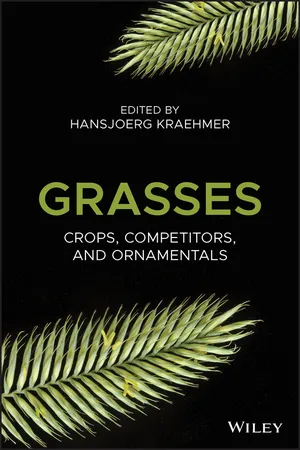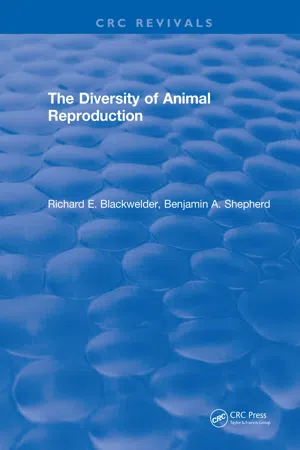Biological Sciences
Double Fertilization
Double fertilization is a unique process in flowering plants where two sperm cells fertilize two different cells within the ovule. One sperm cell fertilizes the egg cell to form the embryo, while the other sperm cell combines with two polar nuclei to form the endosperm, which provides nourishment to the developing embryo. This process is a defining characteristic of angiosperms.
Written by Perlego with AI-assistance
Related key terms
4 Key excerpts on "Double Fertilization"
- eBook - ePub
- T.J. Pandian(Author)
- 2022(Publication Date)
- CRC Press(Publisher)
The advent of gymnosperms marks the transition (i) from ‘aqueous’ fertilization by swimming flagellated spermatozoa in bryophytes and tracheophytes to aerial fertilization by non-motile pollens, and (ii) direct genesis of gametes from naked flowers instead of their production from spores. In them, macro- and micro-spores are generated following meiosis from the respective mother cell. Only one megaspore out of four survive, while all the four microspores are viable, recalling a similar feature in gametogenesis of animals. The surviving megaspore is much larger and retains syncytial organization for long, even up to 3 years. Eventually, it is cellularized and differentiated into two or three archegonia, in each of which a large egg or ovule matures. The microspores, following differentiation into pollens, are dispersed by wind. Within the belatedly developed archegonium, a pollen grain enters through a pollen tube and waits for the maturation of ovule. Eventually, fertilization occurs.In most successful angiosperms, gametogenetic sequences are the same as those of animals. However, the events related to Double Fertilization complicate the sequences. In spite of being a repetition, it may be wiser to recall these events. In them, the pollen grains and ovules are developed within the distinct compact organ, the flowers. The archeospore or Sperm Mother Cell (SMC) in the developing anther meiotically generate a tetrad of microspores, each of which undergoes to mitosis to produce the pollen cell and germ cell, which, in its turn, undergoes mitosis to produce one germ cell to fuse with the ovule and the other to fuse with the 2n central cell to produce a triploid endosperm (Fig. 10.4 ). In the ovary, the enlarged archeospore differentiates into Mega Mother Cell (MMC), which meiotically generates only one surviving Functional Mega Spore (FMS). In its turn, the FMS undertakes three mitotic divisions to produce eight haploid cells. Of them, two fuses to produce the 2n central cell to fuse with one of the pollen sperm cells and one germ cell fuse with that of pollen to produce a 2n zygote (see also p 15). With these two fusions, fertilization in angiosperms is named as Double Fertilization. As a result, the ovules develop into seeds and the ovary into fruit.FIGURE 10.4 Gametogenesis and Double Fertilization in flowering plants.10.3 Gametes and Quantification
Plants generate non-motile and motile gametes in different combinations, which are considered under three major patterns. In the 3,300 speciose Cyanophyceae, only clonal multiplications occur and they do not fall within any pattern (Table 10.2 ). The 6,131 speciose Rhodophyta fall within the pattern IIIa, as they generate non-motile eggs and spermatia. Within pattern I, seven orders of Chlorophyta are included; they also include the less known Xanthophyceae (Salmaso and Tolotti, 2009 ) and Haptophyceae (Eikrem et al., 2017 ), for which values became available with the development of new culturing techniques. In these Chlorophyta, female and male mating types, i.e. the flagellated motile female and male zoospores are produced and released to the exterior. The Phaeophyta (Table 10.2 ) also produce and release female and male zoospores with a pair of unequal flagella borne on the pear-shaped body. Within pattern II, in which the oogamic eggs are retained within a parent body, only the flagellated motile zoospores are released. Unfortunately, no data are available for Pattern II, which may include Chlorophyta like Spirogyra and centric diatoms. However, the value 20,900 species was empirically drawn by subtracting the estimated value of 23,100 species for all other algae (listed Cyanophyceae, Rhodophyta, Chlorophyta and Phaeophyta) from 44,000, the species number, as estimated by Guiry (2012 ). Among algae, 7.5% cyanobionts do not produce gametes; 13.93, 31.07 and 47.50% algae belong to patterns IIIa, I and II, respectively (Table 10.2 - eBook - ePub
Grasses
Crops, Competitors, and Ornamentals
- Hansjoerg Kraehmer(Author)
- 2019(Publication Date)
- Wiley(Publisher)
5 Fertilisation and Fruit Development Hansjoerg Kraehmer1 and Peter Baur2 1 Bayer AG, Weed Control, Industriepark Höchst, Frankfurt am Main, Germany 2 Competence Center, Clariant Innovation Center, Industriepark Höchst Gebäude, August‐Laubenheimer‐Strasse, Frankfurt am Main, Germany5.1 Grass Gametophytes
Fertilisation or syngamy in angiosperms is a process in which haploid microspores fuse with haploid macrospores to form a diploid zygote (Taiz et al. 2015 ). The zygote will divide and finally form the embryo. Both spore forms are the result of meiosis, a process that is described in all modern biology textbooks. Microspores are created within the pollen, macrospores within the embryo sac. The pollen is generated within anthers, the embryo sac within ovules.Pollen tube and the embryo sac are the haploid gametophytes of seed plants.Gametophyte origin and structure of grasses were described for example by De Triquell (1987 ) or by Greenham and Chapman (1990 ).In parallel to the formation of the zygote, a second kind of fertilisation takes place. Another microspore from the pollen fuses with two haploid megaspores to form a triploid endosperm. This endosperm will serve the nutrition of the growing embryo.We will now first describe the grass ovule in which the embryo sac is formed.5.2 The Ovule and the Embryo Sac
The ovule is usually located towards the base of the ovary. In the beginning of its development, the ovary consists of the carpels, the nucellus, and two surrounding, thin sheaths called integuments (Figures 5.1 –5.9 ). Carpels can be regarded as leaf‐like structures bearing ovules (Esau 1977 ). They were previously mentioned in Section 4.1 . A concise overview on the nucellus of monocotyledons was published by Rudall more than 20 years ago (1997 ). Grasses develop two integuments and are called bitegmic. The outer integument exists for a short time only and disappears within a few days after fertilisation (Kellogg 2015 ). Its cells are arranged in characteristic patterns (Figures 5.7 –5.9 ). The inner integument persists and develops in some cases into the seed coat of the fruit. Characteristic of this integument is the continued existence of the cuticle in some species until the fruit is mature (Figure 5.6 - eBook - ePub
- Richard E. Blackwelder(Author)
- 2018(Publication Date)
- CRC Press(Publisher)
Clonal fertilization occurs where asexually produced individuals (a clone) give rise to gametes that fuse. Whenever fertilization involves two individuals with basically identical genomes, such as two produced simultaneously by an asexual process from one parent (such as fragmentation), the fertilization is not cross fertilization but similar to self-fertilization in genetic effect. Clones occur in many classes where they frequently go undetected, but clonal fertilization occurs principally in those colonial forms where gametes are produced and fertilized from within the clone, as well as in animals using polyembryony (especially some Insecta).Self-fertilization (mychogamy) occurs in hermaphrodites when an ovum is fertilized by a spermatozoon produced by the same individual. The gametes are thus from a common genotype. It includes autogamy, paedogamy, and cytogamy. It is theoretically possible in most of the classes that include hermaphrodites, even where there is protandry or protogyny.A similar process in Protozoa that is not actually reproductive is automixis, the fusion of sister nuclei. (See Section II.)Zygotes — The new cell formed by the syngamy and karyogamy is a zygote. It is diploid, formed by fusion of two haploid gametes. It is loosely described as the result of the fertilization of an ovum, implied to be the universal manner of starting a new individual sexually. The fertilization performs two functions: it brings together two genomes to form a new individual, and it activates the new cell to develop.Unfortunately, many new individuals arise from ova that are not fertilized but merely activated by some other means. The newly activated ovum is not a zygote formed by fusion of two haploid gametes. It has therefore been termed an apozygote — a “zygote” formed without fusion. These occur in all forms of parthenogenesis (see the following section). In the eight forms of activation listed below, only the last produces a zygote. All others produce an apozygote. - eBook - ePub
- Charles Adams, Mike Early, Jane Brook, Katherine Bamford(Authors)
- 2015(Publication Date)
- Routledge(Publisher)
The term ‘gamete’ is used to describe the agents, both male and female, that are involved in fertilization. In animals, the gametes are the eggs and sperm. In plants, they are the egg cell (the female gamete) which is a cell in the ovule sometimes called the ovum, and two nuclei in the pollen grain (the male gametes). Gametes are haploid nuclei, they contain only one set of chromosomes.When a pollen grain arrives at the stigma of a plant, it absorbs sugar and moisture from the stigma’s surface and then germinates to produce a pollen tube. The pollen tube contains three nuclei: a pollen tube nucleus which directs the growth of the pollen tube, and two male nuclei (the male gametes). These nuclei are carried in the pollen tube as it grows down inside the style to the ovary and enters the ovule through the micropyle. After entering the ovule, one male nucleus fuses with the ovum (fertilization) and their chromosomes becoming intimately associated to form a zygote, a cell which is diploid. The zygote undergoes repeated cell division of its young unspecialized cells before beginning to develop tissues through differentiation (see p. 106 ), forming the embryo within the mature ovule (the seed).The second male nucleus fuses with two extra (polar) nuclei present in the ovule itself, which are also haploid. The resulting tissue, called the endosperm, consequently contains three sets of chromosomes, that is, its cells are triploid. This Double Fertilization creating both the zygote and the endosperm is unique to angiosperms (Figure 4.17 ).Information on the Genetic Code, inheritance of characteristics and mutations can be found on the companion website (www.routledge.com/cw/adams ).Seeds
Seed structure
A seed is a structure that develops from the ovule following fertilization.As the embryo develops the endosperm or cotyledons swell with food reserve, which may be predominantly oils, such as in Ricinus communis (castor oil plant) and Helianthus annuus (sunflower), or starch as in many leguminous plants such as Phaseolus vulgaris (French bean) and Vicia faba (broad bean). Storage proteins are also produced–for example, legume seeds are an important source of protein in the diet. Different kinds of Zea mays
Learn about this page
Index pages curate the most relevant extracts from our library of academic textbooks. They’ve been created using an in-house natural language model (NLM), each adding context and meaning to key research topics.



